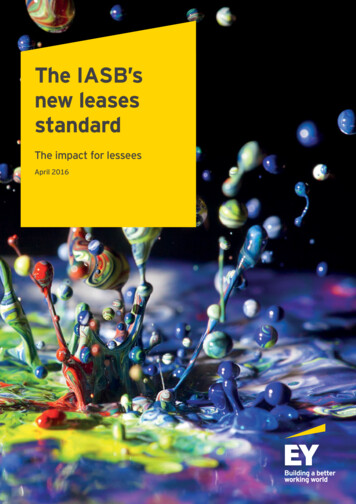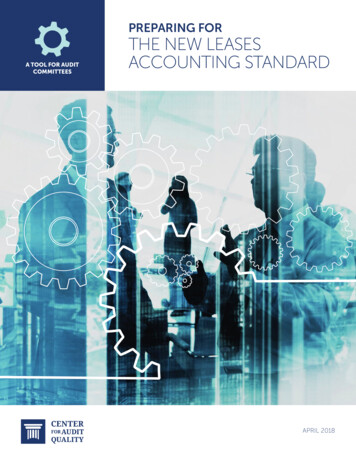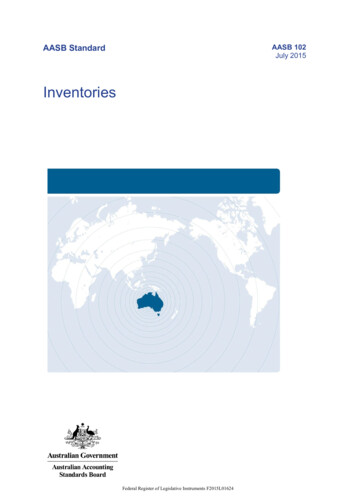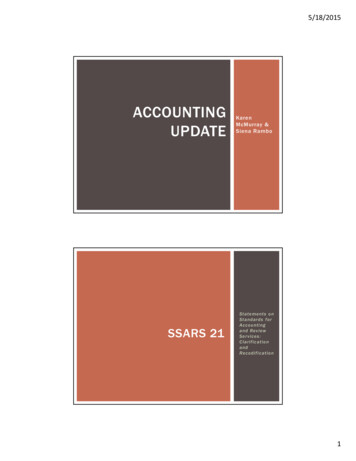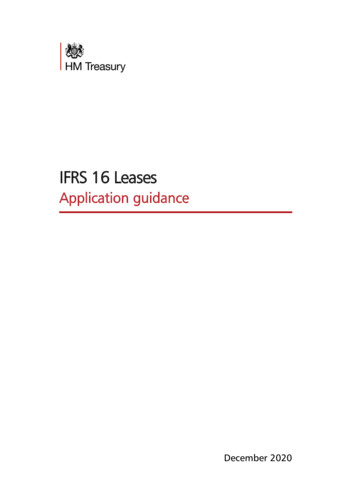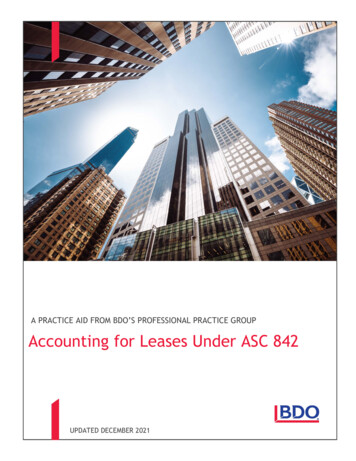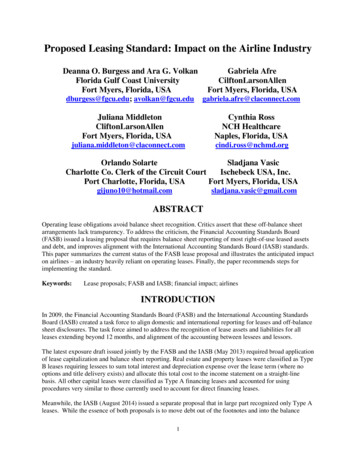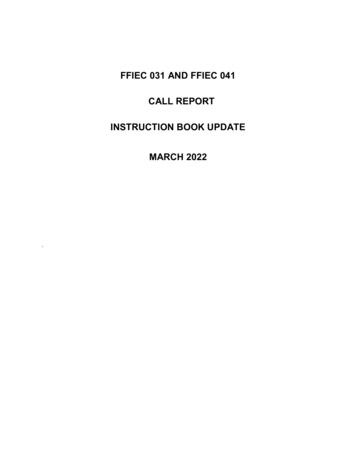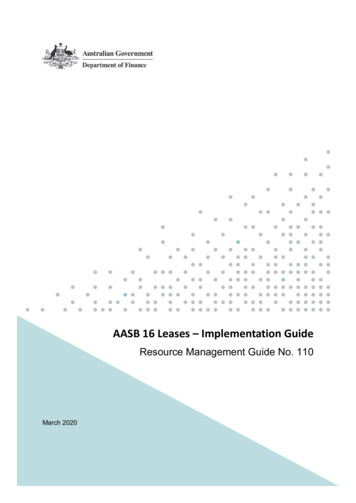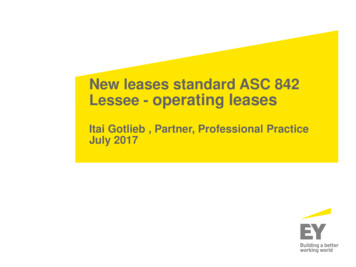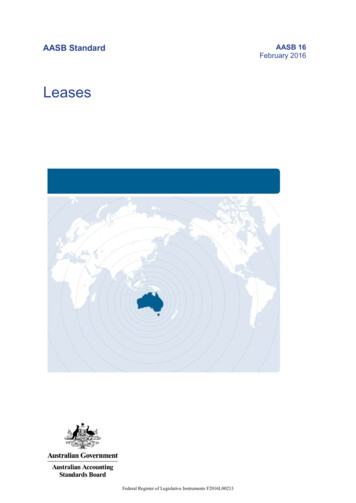
Transcription
AASB 16February 2016AASB StandardLeasesFederal Register of Legislative Instruments F2016L00233
Obtaining a copy of this Accounting StandardThis Standard is available on the AASB website: www.aasb.gov.au.Australian Accounting Standards BoardPO Box 204Collins Street WestVictoria 8007AUSTRALIAPhone:E-mail:Website:(03) 9617 7637publications@aasb.gov.auwww.aasb.gov.auOther enquiriesPhone:E-mail:(03) 9617 7600standard@aasb.gov.auCOPYRIGHT Commonwealth of Australia 2016This AASB Standard contains IFRS Foundation copyright material. Reproduction within Australia in unaltered form(retaining this notice) is permitted for personal and non-commercial use subject to the inclusion of anacknowledgment of the source. Requests and enquiries concerning reproduction and rights for commercial purposeswithin Australia should be addressed to The Director of Finance and Administration, Australian Accounting StandardsBoard, PO Box 204, Collins Street West, Victoria 8007.All existing rights in this material are reserved outside Australia. Reproduction outside Australia in unaltered form(retaining this notice) is permitted for personal and non-commercial use only. Further information and requests forauthorisation to reproduce for commercial purposes outside Australia should be addressed to the IFRS Foundation atwww.ifrs.org.ISSN 1036-4803AASB 162Federal Register of Legislative Instruments F2016L00233COPYRIGHT
ContentsPREFACECOMPARISON WITH IFRS 16ACCOUNTING STANDARDAASB 16 LEASESOBJECTIVESCOPERECOGNITION EXEMPTIONSIDENTIFYING A LEASESeparating components of a contractLesseeLessorLEASE TERMLESSEERecognitionMeasurementInitial measurementInitial measurement of the right-of-use assetInitial measurement of the lease liabilitySubsequent measurementSubsequent measurement of the right-of-use assetSubsequent measurement of the lease liabilityLease ation of leasesFinance leasesRecognition and measurementInitial measurementSubsequent measurementOperating leasesRecognition and measurementLease modificationsPresentationDisclosureFinance leasesOperating leasesSALE AND LEASEBACK TRANSACTIONSAssessing whether the transfer of the asset is a saleTransfer of the asset is a saleTransfer of the asset is not a saleCOMMENCEMENT OF THE LEGISLATIVE INSTRUMENTAPPENDICESA Defined termsAASB 163Federal Register of Legislative Instruments F2016L00233from 88993959899100103Aus103.1CONTENTS
B Application guidanceC Effective date and transitionD Amendments to other StandardsDELETED IFRS 16 TEXTAVAILABLE ON THE AASB WEBSITEIllustrative examplesBasis for Conclusions on IFRS 16Australian Accounting Standard AASB 16 Leases is set out in paragraphs 1 – Aus103.1 and Appendices A – D. Allthe paragraphs have equal authority. Paragraphs in bold type state the main principles. Terms defined in Appendix Aare in italics the first time they appear in the Standard. AASB 16 is to be read in the context of other AustralianAccounting Standards, including AASB 1048 Interpretation of Standards, which identifies the Australian AccountingInterpretations, and AASB 1057 Application of Australian Accounting Standards. In the absence of explicit guidance,AASB 108 Accounting Policies, Changes in Accounting Estimates and Errors provides a basis for selecting andapplying accounting policies.AASB 164Federal Register of Legislative Instruments F2016L00233CONTENTS
PrefaceIntroductionThe Australian Accounting Standards Board (AASB) develops, issues and maintains Australian AccountingStandards, including Interpretations. The AASB is an Australian Government agency under the Australian Securitiesand Investments Commission Act 2001.AASB 1057 Application of Australian Accounting Standards identifies the application of Standards to entities andfinancial statements. AASB 1053 Application of Tiers of Australian Accounting Standards establishes a differentialreporting framework consisting of two tiers of reporting requirements for preparing general purpose financialstatements.What this Standard requiresAASB 16 introduces a single lessee accounting model and requires a lessee to recognise assets and liabilities for allleases with a term of more than 12 months, unless the underlying asset is of low value. A lessee is required torecognise a right-of-use asset representing its right to use the underlying leased asset and a lease liability representingits obligations to make lease payments.A lessee measures right-of-use assets similarly to other non-financial assets (such as property, plant and equipment)and lease liabilities similarly to other financial liabilities. As a consequence, a lessee recognises depreciation of theright-of-use asset and interest on the lease liability, and also classifies cash repayments of the lease liability into aprincipal portion and an interest portion and presents them in the statement of cash flows applying AASB 107Statement of Cash Flows.Assets and liabilities arising from a lease are initially measured on a present value basis. The measurement includesnon-cancellable lease payments (including inflation-linked payments), and also includes payments to be made inoptional periods if the lessee is reasonably certain to exercise an option to extend the lease, or not to exercise anoption to terminate the lease.AASB 16 contains disclosure requirements for lessees. Lessees will need to apply judgement in deciding upon theinformation to disclose to meet the objective of providing a basis for users of financial statements to assess the effectthat leases have on the financial position, financial performance and cash flows of the lessee.AASB 16 substantially carries forward the lessor accounting requirements in AASB 117 Leases. Accordingly, alessor continues to classify its leases as operating leases or finance leases, and to account for those two types of leasesdifferently.AASB 16 also requires enhanced disclosures to be provided by lessors that will improve information disclosed about alessor’s risk exposure, particularly to residual value risk.Application dateThis Standard is applicable to annual reporting periods beginning on or after 1 January 2019 (see paragraph C1).Earlier application is permitted for entities that apply AASB 15 Revenue from Contracts with Customers at or beforethe date of initial application of this Standard.Why we have issued this StandardLeasing is an important activity for many entities. It is a means of gaining access to assets, of obtaining finance andof reducing an entity’s exposure to the risks of asset ownership. The prevalence of leasing means that it is importantthat users of financial statements have a complete and understandable picture of an entity’s leasing activities.The previous accounting model for leases required lessees and lessors to classify their leases as either finances leasesor operating leases and account for those two types of leases differently. That model was criticised for failing to meetthe needs of users of financial statements because it did not always provide a faithful representation of leasingtransactions. In particular, it did not require lessees to recognise assets and liabilities arising from operating leases.Accordingly, the International Accounting Standards Board (IASB) and the US national standard-setter, the FinancialAccounting Standards Board (FASB), initiated a joint project to develop a new approach to lease accounting thatrequires a lessee to recognise assets and liabilities for the rights and obligations created by leases. This approach willAASB 165Federal Register of Legislative Instruments F2016L00233PREFACE
result in a more faithful representation of a lessee’s assets and liabilities and, together with enhanced disclosures, willprovide greater transparency of a lessee’s financial leverage and capital employed.Reduced disclosure requirementsDisclosure requirements under Tier 2 will be determined through a separate due process with amendments being madesubsequently to this Standard as required.AASB 166Federal Register of Legislative Instruments F2016L00233PREFACE
Comparison with IFRS 16AASB 16 Leases incorporates IFRS 16 Leases issued by the International Accounting Standards Board (IASB).Australian-specific paragraphs (which are not included in IFRS 16) are identified with the prefix “Aus”. Paragraphsthat apply only to not-for-profit entities begin by identifying their limited applicability.Tier 1For-profit entities complying with AASB 16 also comply with IFRS 16.Not-for-profit entities’ compliance with IFRS 16 will depend on whether any “Aus” paragraphs that specifically applyto not-for-profit entities provide additional guidance or contain applicable requirements that are inconsistent withIFRS 16.AASB 1053 Application of Tiers of Australian Accounting Standards explains the two tiers of reporting requirements.AASB 167Federal Register of Legislative Instruments F2016L00233COMPARISON
Accounting Standard AASB 16The Australian Accounting Standards Board makes Accounting Standard AASB 16 Leases under section 334 of theCorporations Act 2001.Kris PeachChair – AASBDated 23 February 2016Accounting Standard AASB 16LeasesObjective1This Standard sets out the principles for the recognition, measurement, presentation and disclosureof leases. The objective is to ensure that lessees and lessors provide relevant information in a mannerthat faithfully represents those transactions. This information gives a basis for users of financialstatements to assess the effect that leases have on the financial position, financial performance andcash flows of an entity.2An entity shall consider the terms and conditions of contracts and all relevant facts and circumstances whenapplying this Standard. An entity shall apply this Standard consistently to contracts with similarcharacteristics and in similar circumstances.Scope34An entity shall apply this Standard to all leases, including leases of right-of-use assets in a sublease, exceptfor:(a)leases to explore for or use minerals, oil, natural gas and similar non-regenerative resources;(b)leases of biological assets within the scope of AASB 141 Agriculture held by a lessee;(c)service concession arrangements within the scope of Interpretation 12 Service ConcessionArrangements;(d)licences of intellectual property granted by a lessor within the scope of AASB 15 Revenue fromContracts with Customers; and(e)rights held by a lessee under licensing agreements within the scope of AASB 138 IntangibleAssets for such items as motion picture films, video recordings, plays, manuscripts, patents andcopyrights.A lessee may, but is not required to, apply this Standard to leases of intangible assets other than thosedescribed in paragraph 3(e).Recognition exemptions (paragraphs B3–B8)5A lessee may elect not to apply the requirements in paragraphs 22–49 to:(a)short-term leases; and(b)leases for which the underlying asset is of low value (as described in paragraphs B3–B8).6If a lessee elects not to apply the requirements in paragraphs 22–49 to either short-term leases or leases forwhich the underlying asset is of low value, the lessee shall recognise the lease payments associated withthose leases as an expense on either a straight-line basis over the lease term or another systematic basis. Thelessee shall apply another systematic basis if that basis is more representative of the pattern of the lessee’sbenefit.7If a lessee accounts for short-term leases applying paragraph 6, the lessee shall consider the lease to be anew lease for the purposes of this Standard if:(a)AASB 16there is a lease modification; or8Federal Register of Legislative Instruments F2016L00233STANDARD
(b)8there is any change in the lease term (for example, the lessee exercises an option not previouslyincluded in its determination of the lease term).The election for short-term leases shall be made by class of underlying asset to which the right of userelates. A class of underlying asset is a grouping of underlying assets of a similar nature and use in anentity’s operations. The election for leases for which the underlying asset is of low value can be made on alease-by-lease basis.Identifying a lease (paragraphs B9–B33)9At inception of a contract, an entity shall assess whether the contract is, or contains, a lease. Acontract is, or contains, a lease if the contract conveys the right to control the use of an identifiedasset for a period of time in exchange for consideration. Paragraphs B9–B31 set out guidance on theassessment of whether a contract is, or contains, a lease.10A period of time may be described in terms of the amount of use of an identified asset (for example, thenumber of production units that an item of equipment will be used to produce).11An entity shall reassess whether a contract is, or contains, a lease only if the terms and conditions of thecontract are changed.Separating components of a contract12For a contract that is, or contains, a lease, an entity shall account for each lease component within thecontract as a lease separately from non-lease components of the contract, unless the entity applies thepractical expedient in paragraph 15. Paragraphs B32–B33 set out guidance on separating components of acontract.Lessee13For a contract that contains a lease component and one or more additional lease or non-lease components, alessee shall allocate the consideration in the contract to each lease component on the basis of the relativestand-alone price of the lease component and the aggregate stand-alone price of the non-lease components.14The relative stand-alone price of lease and non-lease components shall be determined on the basis of theprice the lessor, or a similar supplier, would charge an entity for that component, or a similar component,separately. If an observable stand-alone price is not readily available, the lessee shall estimate the standalone price, maximising the use of observable information.15As a practical expedient, a lessee may elect, by class of underlying asset, not to separate non-leasecomponents from lease components, and instead account for each lease component and any associated nonlease components as a single lease component. A lessee shall not apply this practical expedient to embeddedderivatives that meet the criteria in paragraph 4.3.3 of AASB 9 Financial Instruments.16Unless the practical expedient in paragraph 15 is applied, a lessee shall account for non-lease componentsapplying other applicable Standards.Lessor17For a contract that contains a lease component and one or more additional lease or non-lease components, alessor shall allocate the consideration in the contract applying paragraphs 73–90 of AASB 15.Lease term (paragraphs B34–B41)1819AASB 16An entity shall determine the lease term as the non-cancellable period of a lease, together with both:(a)periods covered by an option to extend the lease if the lessee is reasonably certain to exercise thatoption; and(b)periods covered by an option to terminate the lease if the lessee is reasonably certain not toexercise that option.In assessing whether a lessee is reasonably certain to exercise an option to extend a lease, or not to exercisean option to terminate a lease, an entity shall consider all relevant facts and circumstances that create an9Federal Register of Legislative Instruments F2016L00233STANDARD
economic incentive for the lessee to exercise the option to extend the lease, or not to exercise the option toterminate the lease, as described in paragraphs B37–B40.2021A lessee shall reassess whether it is reasonably certain to exercise an extension option, or not to exercise atermination option, upon the occurrence of either a significant event or a significant change incircumstances that:(a)is within the control of the lessee; and(b)affects whether the lessee is reasonably certain to exercise an option not previously included in itsdetermination of the lease term, or not to exercise an option previously included in itsdetermination of the lease term (as described in paragraph B41).An entity shall revise the lease term if there is a change in the non-cancellable period of a lease. Forexample, the non-cancellable period of a lease will change if:(a)the lessee exercises an option not previously included in the entity’s determination of the leaseterm;(b)the lessee does not exercise an option previously included in the entity’s determination of thelease term;(c)an event occurs that contractually obliges the lessee to exercise an option not previously includedin the entity’s determination of the lease term; or(d)an event occurs that contractually prohibits the lessee from exercising an option previouslyincluded in the entity’s determination of the lease term.LesseeRecognition22At the commencement date, a lessee shall recognise a right-of-use asset and a lease liability.MeasurementInitial measurementInitial measurement of the right-of-use asset23At the commencement date, a lessee shall measure the right-of-use asset at cost.24The cost of the right-of-use asset shall comprise:25(a)the amount of the initial measurement of the lease liability, as described in paragraph 26;(b)any lease payments made at or before the commencement date, less any lease incentives received;(c)any initial direct costs incurred by the lessee; and(d)an estimate of costs to be incurred by the lessee in dismantling and removing the underlyingasset, restoring the site on which it is located or restoring the underlying asset to the conditionrequired by the terms and conditions of the lease, unless those costs are incurred to produceinventories. The lessee incurs the obligation for those costs either at the commencement date or asa consequence of having used the underlying asset during a particular period.A lessee shall recognise the costs described in paragraph 24(d) as part of the cost of the right-of-use assetwhen it incurs an obligation for those costs. A lessee applies AASB 102 Inventories to costs that areincurred during a particular period as a consequence of having used the right-of-use asset to produceinventories during that period. The obligations for such costs accounted for applying this Standard orAASB 102 are recognised and measured applying AASB 137 Provisions, Contingent Liabilities andContingent Assets.Initial measurement of the lease liability26AASB 16At the commencement date, a lessee shall measure the lease liability at the present value of the leasepayments that are not paid at that date. The lease payments shall be discounted using the interest rate10Federal Register of Legislative Instruments F2016L00233STANDARD
implicit in the lease, if that rate can be readily determined. If that rate cannot be readily determined,the lessee shall use the lessee’s incremental borrowing rate.2728At the commencement date, the lease payments included in the measurement of the lease liability comprisethe following payments for the right to use the underlying asset during the lease term that are not paid at thecommencement date:(a)fixed payments (including in-substance fixed payments as described in paragraph B42), less anylease incentives receivable;(b)variable lease payments that depend on an index or a rate, initially measured using the index orrate as at the commencement date (as described in paragraph 28);(c)amounts expected to be payable by the lessee under residual value guarantees;(d)the exercise price of a purchase option if the lessee is reasonably certain to exercise that option(assessed considering the factors described in paragraphs B37–B40); and(e)payments of penalties for terminating the lease, if the lease term reflects the lessee exercising anoption to terminate the lease.Variable lease payments that depend on an index or a rate described in paragraph 27(b) include, forexample, payments linked to a consumer price index, payments linked to a benchmark interest rate (such asLIBOR) or payments that vary to reflect changes in market rental rates.Subsequent measurementSubsequent measurement of the right-of-use asset29After the commencement date, a lessee shall measure the right-of-use asset applying a cost model,unless it applies either of the measurement models described in paragraphs 34 and 35.Cost model30To apply a cost model, a lessee shall measure the right-of-use asset at cost:(a)less any accumulated depreciation and any accumulated impairment losses; and(b)adjusted for any remeasurement of the lease liability specified in paragraph 36(c).31A lessee shall apply the depreciation requirements in AASB 116 Property, Plant and Equipment indepreciating the right-of-use asset, subject to the requirements in paragraph 32.32If the lease transfers ownership of the underlying asset to the lessee by the end of the lease term or if thecost of the right-of-use asset reflects that the lessee will exercise a purchase option, the lessee shalldepreciate the right-of-use asset from the commencement date to the end of the useful life of the underlyingasset. Otherwise, the lessee shall depreciate the right-of-use asset from the commencement date to theearlier of the end of the useful life of the right-of-use asset or the end of the lease term.33A lessee shall apply AASB 136 Impairment of Assets to determine whether the right-of-use asset isimpaired and to account for any impairment loss identified.Other measurement models34If a lessee applies the fair value model in AASB 140 Investment Property to its investment property, thelessee shall also apply that fair value model to right-of-use assets that meet the definition of investmentproperty in AASB 140.35If right-of-use assets relate to a class of property, plant and equipment to which the lessee applies therevaluation model in AASB 116, a lessee may elect to apply that revaluation model to all of the right-of-useassets that relate to that class of property, plant and equipment.Subsequent measurement of the lease liability36AASB 16After the commencement date, a lessee shall measure the lease liability by:(a)increasing the carrying amount to reflect interest on the lease liability;(b)reducing the carrying amount to reflect the lease payments made; and11Federal Register of Legislative Instruments F2016L00233STANDARD
(c)remeasuring the carrying amount to reflect any reassessment or lease modificationsspecified in paragraphs 39–46, or to reflect revised in-substance fixed lease payments (seeparagraph B42).37Interest on the lease liability in each period during the lease term shall be the amount that produces aconstant periodic rate of interest on the remaining balance of the lease liability. The periodic rate of interestis the discount rate described in paragraph 26, or if applicable the revised discount rate described inparagraph 41, paragraph 43 or paragraph 45(c).38After the commencement date, a lessee shall recognise in profit or loss, unless the costs are included in thecarrying amount of another asset applying other applicable Standards, both:(a)interest on the lease liability; and(b)variable lease payments not included in the measurement of the lease liability in the period inwhich the event or condition that triggers those payments occurs.Reassessment of the lease liability39After the commencement date, a lessee shall apply paragraphs 40–43 to remeasure the lease liability toreflect changes to the lease payments. A lessee shall recognise the amount of the remeasurement of the leaseliability as an adjustment to the right-of-use asset. However, if the carrying amount of the right-of-use assetis reduced to zero and there is a further reduction in the measurement of the lease liability, a lessee shallrecognise any remaining amount of the remeasurement in profit or loss.40A lessee shall remeasure the lease liability by discounting the revised lease payments using a reviseddiscount rate, if either:(a)there is a change in the lease term, as described in paragraphs 20–21. A lessee shall determine therevised lease payments on the basis of the revised lease term; or(b)there is a change in the assessment of an option to purchase the underlying asset, assessedconsidering the events and circumstances described in paragraphs 20–21 in the context of apurchase option. A lessee shall determine the revised lease payments to reflect the change inamounts payable under the purchase option.41In applying paragraph 40, a lessee shall determine the revised discount rate as the interest rate implicit inthe lease for the remainder of the lease term, if that rate can be readily determined, or the lessee’sincremental borrowing rate at the date of reassessment, if the interest rate implicit in the lease cannot bereadily determined.42A lessee shall remeasure the lease liability by discounting the revised lease payments, if either:43(a)there is a change in the amounts expected to be payable under a residual value guarantee. A lesseeshall determine the revised lease payments to reflect the change in amounts expected to bepayable under the residual value guarantee.(b)there is a change in future lease payments resulting from a change in an index or a rate used todetermine those payments, including for example a change to reflect changes in market rentalrates following a market rent review. The lessee shall remeasure the lease liability to reflect thoserevised lease payments only when there is a change in the cash flows (ie when the adjustment tothe lease payments takes effect). A lessee shall determine the revised lease payments for theremainder of the lease term based on the revised contractual payments.In applying paragraph 42, a lessee shall use an unchanged discount rate, unless the change in leasepayments results from a change in floating interest rates. In that case, the lessee shall use a revised discountrate that reflects changes in the interest rate.Lease modifications4445AASB 16A lessee shall account for a lease modification as a separate lease if both:(a)the modification increases the scope of the lease by adding the right to use one or moreunderlying assets; and(b)the consideration for the lease increases by an amount commensurate with the stand-alone pricefor the increase in scope and any appropriate adjustments to that stand-alone price to reflect thecircumstances of the particular contract.For a lease modification that is not accounted for as a separate lease, at the effective date of the leasemodification a lessee shall:12Federal Register of Legislative Instruments F2016L00233STANDARD
46(a)allocate the consideration in the modified contract applying paragraphs 13–16;(b)determine the lease term of the modified lease applying paragraphs 18–19; and(c)remeasure the lease liability by discounting the revised lease payments using a revised discountrate. The revised discount rate is determined as the interest rate implicit in the lease for theremainder of the lease term, if that rate can be readily determined, or the lessee’s incrementalborrowing rate at the effective date of the modification, if the interest rate implicit in the leasecannot be readily determined.For a lease modification that is not accounted for as a separate lease, the lessee shall account for theremeasurement of the lease liability by:(a)decreasing the carrying amount of the right-of-use asset to reflect the partial or full termination ofthe lease for lease modifications that decrease the scope of the lease. The lessee shall recognise inprofit or loss any gain or loss relating to the partial or full termination of the lease.(b)making a corresponding adjustment to the right-of-use asset for all other lease modifications.Presentation47A lessee shall either present in the statement of financial position, or disclose in the notes:(a)(b)right-of-use assets separately from other assets. If a lessee does not present right-of-use assetsseparately in the statement of financial position, the lessee shall:(i)include right-of-use assets within the same line item as that within which thecorresponding underlying assets would be presented if they were owned; and(ii)disclose which line items in the statement of financial position include those right-ofuse assets.lease liabilities separately from other liabilities. If the lessee does not present lease liabilitiesseparately in the statement of financial position, the lessee shall disclose which line items in thestatement of financial position include those liabilities.48The requirement in paragraph 47(a) does not apply to right-of-use assets that meet the definition ofinvestment property, which shall be presented in the statement of financial position as investment property.49In the statement of profit or loss and other comprehensive income, a lessee shall present interest expense onthe lease liability separately from the depreciation charge for the right-of-use asset. Interest expense on thelease liability is a component of finance costs, which paragraph 82(b) of AASB 101 Presentation ofFinancial Statements requires to be presented separately in the statement of profit or loss and othercomprehensive income.50In the statement of cash flows, a lessee shall classify:(a)cash payments for the principal portion of the lease liability within financing activities;(b)cash payments for the interest portion of the lease liability applying the requirements inAASB 107 Statement of Cash Flows for interest paid; and(c)short-term lease payments, payments for leases of low-value assets and variable lease paymentsnot included in the measurement of the lease liability within operating activities.Disclosure51The objective of the disclosures is for lessees to disclose information in the notes that, together withthe information provided in the statement of financial position, statement of profit or loss andstatement of cash flows, gives a basis for users of financial statements to assess the effect that leaseshave on the financial position, financial performance and cash flows of the lessee. Paragraphs 52–60specify requirements on h
8 The election for short-term leases shall be made by class of underlying asset to which the right of use relates. A class of underlying asset is a grouping of underlying assets of a similar nature and use in an entity's operations. The election for leases for which the underlying asset is of low value can be made on a lease-by-lease basis.
